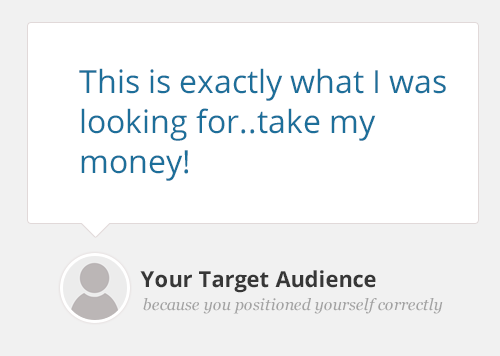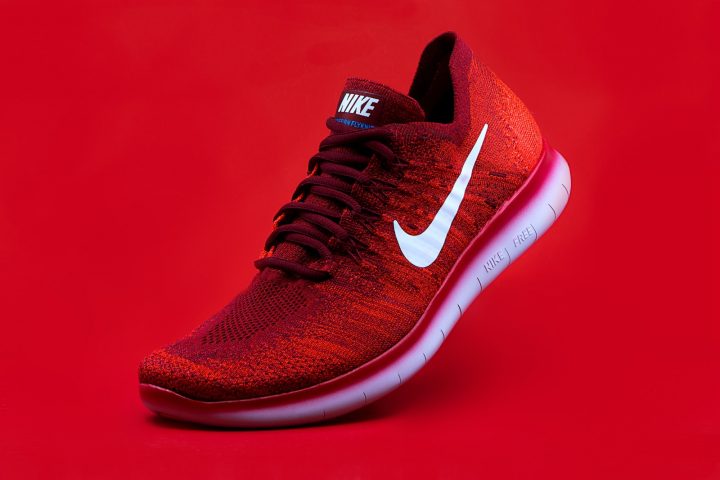
Product positioning is a technique used in marketing that seeks to bring a specific idea to mind when presented to an audience. For example, when I think of Apple laptops, I think of “high-end laptops geared towards creatives.” When I think of HP laptops, I think of “affordable laptops geared towards the masses.” These are product positions, and they are re-iterated by the marketing, the pricing, and the design of the products themselves.
Identifying a product positioning goal is an important step in building the foundation for your strategic marketing plans for the future.
Product Positioning Questions
When people decide to sign up for your app, they typically need to have the following questions answered:
- Who is this product for? Is it for me?
- What does this product do?
- Why is this product helpful?
- Why should I pay X for it?
- When would I use this product?
- How is it different from product X?
- Who else is using this product?
The answers to the above questions can all be found in how you position your product. To continue with the Apple example in the intro, it isn’t difficult to answer all of these questions as they relate to the Apple brand.
To show just how deeply Apple has gone into developing its brand, we’ll deep-dive into the last question, “Who is using this product?” While Apple doesn’t specifically list other companies that own Apple products on their website, they have spent quite a bit of money putting Apple devices into the hands of folks that we relate with regularly, television characters:
- Phil Dunphy (Middle-Class Dad, Modern Family)
- Jack Donaghy (Executive, 30 Rock)
- Ethan Hunt (Tech-laden Hero, Mission Impossible)
- Elle Woods (Student, Legally Blonde)
- Jack Bauer (Badass, 24)
- Michael Scott (Middle Management, The Office)
- Carrie Bradshaw (City Girl, Sex and the City)
These product placements are also meant to keep Apple in the forefront of the audience’s mind, but it helps that within this group there is usually someone that their target audience can relate to, and therefore answer the question with “These products are for me.”
How Do You Position Your SaaS App?
At Harpoon, our target audience is freelancers who experience an ebb and flow of income. Most freelancers have a general idea of what they’d like to make in a year, but few take the time to set goals and do the math necessary for their progress. We built Harpoon to automate this process, showing freelancers exactly when they need a kick in the pants, or when it is okay to slow things down and still hit their goals.
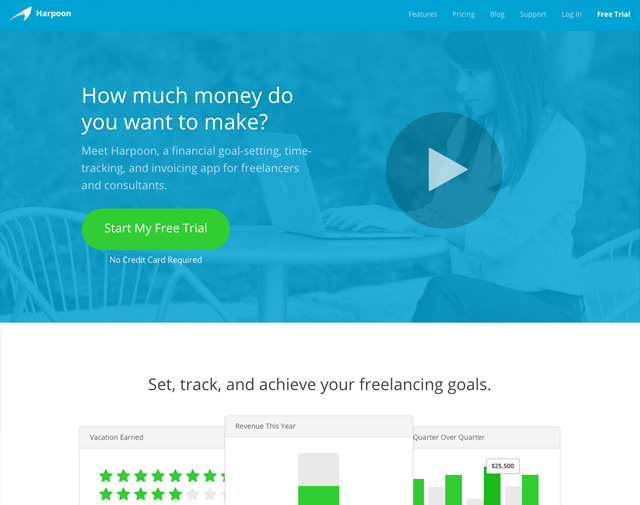
Our homepage starts with a question: “How much money do you want to make?” It’s meant to grab attention and empower freelancers to remind them that they are in control of achieving their goals. This then leads into our second headline, “Set, track, and achieve your freelancing goals”, a value proposition for what the product helps you do. The strategy we are using here is to:
- Grab attention
- Cause reflection
- Offer a better way
There are various positioning angles that you can take when positioning your product. The best executions typically chose just one position statement and try to drive it home.
The following are a few other positioning strategies as observed out in the wild:
Key Benefits Strategy
One of the most popular methods for positioning a SaaS product is to drive home the key benefits. How does this product provide value? If the marketing site’s homepage can answer this question within 3 seconds, and if it aligns with the desire of the audience, then you’ve got a hook.
A great example of this product position strategy is ConvertKit’s homepage:
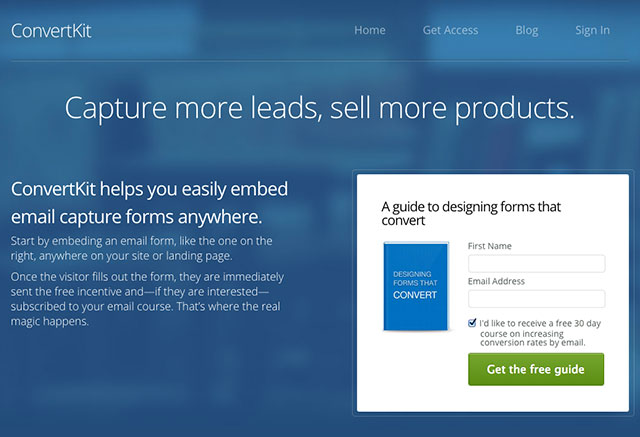
The headline, “Capture more leads, sell more products” instantly starts to sell the value of the product. If you are in the business of attracting leads or selling products, then you’ll be interested in reading more. If you are not at all interested in selling products or capturing leads, then you’ll likely bounce from this homepage rather quickly. That’s okay, however, because the product isn’t for you. What’s important is that for those that the product is for, it was apparent rather quickly.
For the majority of SaaS applications, this is a great default strategy. Tout how your customer benefits from using your application.
Key Attributes Strategy
Closely related to your benefits are your attributes or features. What exactly does this application do? While ConvertKit does eventually describe what the application does, it starts with how your business will be affected positively by using it.
In contrast, the Baremetrics homepage begins by touting exactly what the application does:
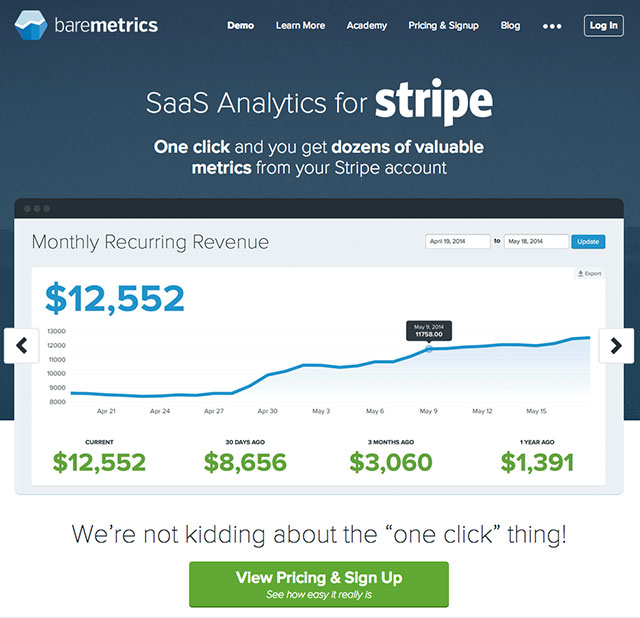
“SaaS Analytics for Stripe.” You either need them or you don’t. If you do need them, you’ll like the first stated feature of the application, “One click and you get dozens of valuable metrics from your Stripe account.” The focus here is on the “one-click,” a pretty compelling application feature since most people who are running SaaS businesses are manually copying data into a spreadsheet from Stripe to calculate a variety of metrics.
This type of product positioning is most effective when you are solving a technical pain point, and the audience can understand the benefit of your solution very quickly. Such is the case for Baremetrics. Key feature positioning wouldn’t work as well for something like a productivity app, were touting the benefits like “Get more done in less time” would be more effective than saying “Groups of checkbox lists” as the main marketing headline.
Use Cases Strategy
For some products, highlighting a specific use case can be effective. For Freckle, an online time tracker, the marketing site begins with a quote from a customer describing a pain point:
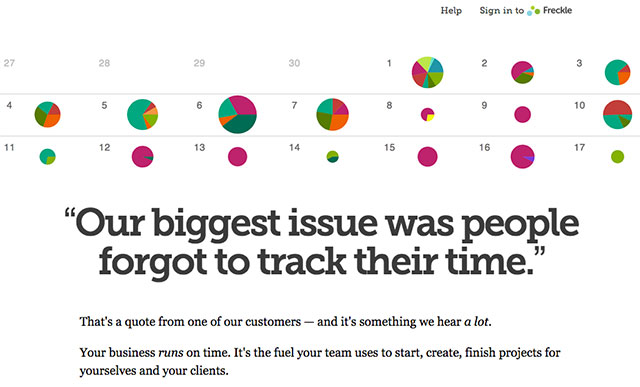
“Our biggest issue was people forgot to track their time.” This puts a particular pain point at the forefront of the marketing strategy. I don’t have this pain point, so I immediately make a mental decision that this product isn’t for me. However, if I was running an agency with a handful of employees, and had a hard time getting an accurate account of hours that everyone was putting into a project so I could bill accordingly, this would speak very loudly to me, and I’d be getting ready to pull out my wallet.
This approach has the tradeoff of turning away anyone that doesn’t have that exact need, but the strength of not only appealing immediately to those with the pain point but also planting a seed of trust, since the makers of this app seem to get where I’m coming from.
In the case of Freckle, one of the founders (Amy Hoy) has been generous enough to write out her thought process behind choosing this strategy for positioning her product. She states that the company wanted to focus more on teams, not individuals because the former are more profitable for the business. Also, with this copywriting change (and a handful of other factors), their conversion went up 2.4x, not to mention the growth in revenue from the focus on teams.
Use this strategy when you want to establish credibility quickly by aiming your crosshairs at a specific problem.
Target Customers Strategy
In some cases, positioning your product as a solution for a particular target customer can be a big win. The team behind You Need a Budget pretty much defines their ideal customer right on their homepage with a few subtle clues:
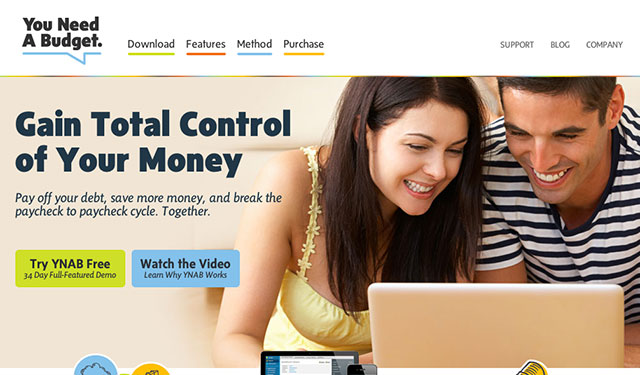
At first glance, the headline “Gain Total Control of Your Money” would lead me to believe that this is perhaps an example of positioning against a benefit, but there are a few other cues that also define their ideal customer:
- A young, middle-class couple (Photo)
- Who has debt (“Pay off debt”)
- Who wants to save more (“Save more money”)
- Who probably doesn’t have a lot saved now (“Break the paycheck to paycheck cycle”)
- Who wants to work together as a couple (“Together.”)
I would say that everybody would like to gain total control of their money, but if I fell into that demographic described above, then I would feel like this product was exactly what I needed…that it was tailored just for me.
Just out of curiosity, I did a little demographic recon to try to determine just about how many people might fit into this description. This is a quick and dirty estimation, but I found out that:
- There are 60.3 million married couples in the US (source)
- About 44% of the American population over age 19 is between the ages of 25 and 44. (source)
- About 35% of Americans have unpaid bills (source)
- About 44% of Americans consider themselves in the middle class. (source)
Taking these numbers into consideration, the estimate is that there are at least 5-10 million American couples that fit the target customer exactly. I am also making an assumption here by talking about the Americans only, I’m sure the software has an international customer base.
That’s millions of people that, when coming across the homepage of You Need A Budget, say to themselves “That’s me exactly”.
Use this strategy when you want to establish credibility quickly by aiming your crosshairs at a specific demographic. The more specific the stronger the attraction to those who fit the profile.
Against the Competition Strategy
The last product positioning strategy that I’d like to highlight is drawing a direct comparison between your product and the competition. The team behind Kissmetrics, an analytics app, has as their competition Google Analytics, a free product by one of the most recognizable brands in the world. By realizing that most of their target audience has probably already used Google Analytics in the past, they cut right to the chase by highlighting their competitive advantage:
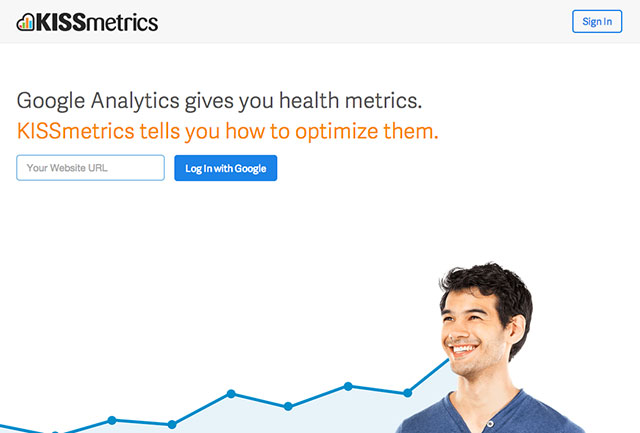
Kissmetrics tells you how to optimize your analytics, or gives you actionable advice. As a user of Google Analytics, I know that it is a flood of data that takes time to wade through and understand to the point of deriving value beyond vanity metrics like daily page views. Coming across a product that gives me advice on what to do about them and distills it down to the most important metrics would be worth considering. In a sense, I’m praying for someone to “tell me what to do”, and that is a competitive advantage over Google Analytics.
Another company with a similar approach is the team behind Less Accounting. The current go-to accounting tool is QuickBooks. They’re the market leader, they have cross-platform desktop apps, mobile apps, and a SaaS application. They’re everywhere. During my first meeting with my accountant, he asked me if I used QuickBooks, and I’m assuming it is the tool that the vast majority of small businesses use.
Again, there is room for a competitive advantage here, because many people consider QuickBooks to be confusing. Because it has to appeal to all types of businesses, large and small, it can be confusing for many who just want a simple solution. Right on the Less Accounting homepage, the marketing message draws attention to someone who might want to leave QuickBooks because “that software is confusing!”:
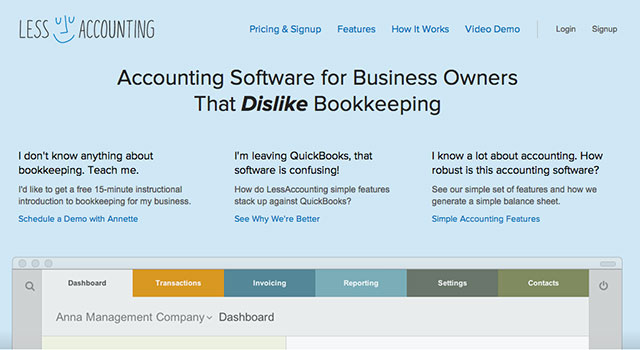
They even have a dedicated page that talks directly about the benefits of Less Accounting as an alternative to QuickBooks.
If your product has some pretty formidable competition, perhaps highlighting your advantages with your product positioning is the best bet for drawing in new users.
Conclusion
Having a product positioning strategy is the seed from which your marketing copy, advertising channels, and product design will grow. As opposed to a vague position that tries to be multiple things to multiple people, committing to a strong, single position will cause the right people to see your marketing material and think, “This is exactly what I needed.”
